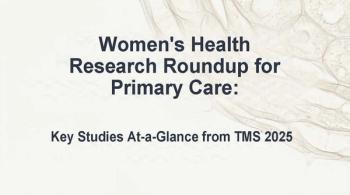
Obesity Redefined: 1 in 5 Adults Reclassified Under New EASO Criteria
Individuals newly classified with obesity using the European framework were found to be overall sicker and at greater risk for mortality.
A new analysis of US population health data suggests that nearly 1 in 5 adults previously classified as overweight by body mass index (BMI) would now be diagnosed with obesity under a revised framework developed by the European Association for the Study of Obesity (EASO).
In a nationally representative sample of 44,030 US adults, researchers found that the new definition identified a large subgroup with substantial clinical morbidity, including hypertension, diabetes, and cardiovascular disease, who were not captured by BMI alone.
Researchers found that although the newly reclassified persons with obesity (PWO) were not at greater risk for mortality compared with those with normal weight overall, their adjusted risk for death was 50% higher when compared to metabolically healthy adults of normal weight. The findings, published in the Annals of Internal Medicine, highlight the potential of the EASO framework to detect obesity-related risk earlier and more precisely than BMI alone.1
“An entire population of persons who were previously considered overweight based on their BMI will now require appropriate clinical attention,” lead author Dror Dicker, MD, head of department of internal medicine and obesity clinic at the Hasharon Hospital-Rabin Medical Centre of Tel Aviv University in Israel and colleagues wrote. While costs associated with the increased numbers will increase at first, they added, a renewed focus on "prevention, earlier diagnosis, and enabling more effective newer treatments, outcomes are likely to improve and reduce the stigma and burden of obesity disease.” 1
The study was designed to evaluate the implications of EASO’s newly proposed definition, which combines BMI, waist-to-height ratio (WHtR), and the presence of medical, functional, or psychological comorbidities.2 Researchers analyzed data from the National Health and Nutrition Examination Survey (NHANES) from 1999 to 2018, linked to mortality outcomes. They classified adults using both the traditional BMI categories and the new EASO definition, which identifies obesity either by a BMI of 30 kg/m² or greater or by a BMI between 25 and and less than 30 kg/m² with a WHtR of equal to or greater than 0.5 and at least one obesity-related complication.1
FINDINGS
Using BMI alone classified 35.4% of adults as having obesity. Using the EASO definition, 18.8% of individuals previously labeled overweight were newly identified as having obesity, raising the total PWO prevalence to 54.2%. Among this newly identified group, common comorbidities included hypertension (79.9%), arthritis (33.2%), diabetes (15.6%), and cardiovascular disease (10.5%). Compared with those classified with obesity by BMI, the overall burden of comorbidity was greater, according to the study: 57.5% had 1 comorbidity, and 42.5% had more than 1, compared with 34.3% and 38.7%, respectively, among PWO based on BMI alone. The researchers also found that the newly classified group was overall older (mean age 51.3 vs 45.4 years) and more likely to be male.1
Nuanced Mortality Risk
In mortality analyses, the study found nuanced risk differences. When compared to individuals with BMI less than 25 kg/m², those with a BMI of 30 kg/m² or greater had a 19% higher risk of death (HR 1.19, 95% CI 1.08–1.32). Among the newly reclassified PWO, however, Dicker and colleagues found no excess mortality risk compared to all adults of normal weight (HR 0.98, 95% CI 0.87–1.10). In analysis that restricted the reference group to normal-weight individuals without comorbidities, however, the hazard ratio for the newly identified PWO rose to 1.50 (95% CI 1.20–1.88). This excess risk was on par with the mortality risk observed among normal-weight individuals who had at least one comorbidity (HR 1.74, 95% CI 1.34–2.22).1
An entire population of persons who were previously considered overweight based on their BMI will now require appropriate clinical attention.
The findings support calls for obesity definitions that go beyond BMI and account for functional and clinical status, the authors wrote. They emphasized that more than half of individuals classified as overweight by BMI alone had comorbidities that would qualify them as PWO under the new framework, a strong suggestion that clinically significant disease is being underrecognized. The EASO framework's predictive performance was consistent across age, sex, and race subgroups, the authors said.1
Among the study's limitations Dicker et al acknowledge the cross-sectional design, single-time-point anthropometric measures, and possible residual confounding. Mortality risk among newly identified PWO may also be biased by unmeasured factors, such as unintentional weight loss in the normal BMI group.
"The new EASO framework may provide a more sensitive tool to diagnose obesity than the traditional BMI definition," the group wrote, "but whether these newly identified adults with obesity would benefit comparably [with] obesity treatment as those traditionally included in treatment trials is uncertain."1
Future studies should examine outcomes and treatment responses in this group and further refine WHtR cutoffs across diverse populations, they concluded.
References
Dicker D, Karpati T, Promislow S, Reges O. Implications of the European Association for the Study of Obesity’s new framework definition of obesity: Prevalence and association with all-cause mortality. Ann Intern Med. Published online July 8, 2025. doi:10.7326/ANNALS-24-02547
Busetto L, Dicker D, Frühbeck G, et al. A new framework for the diagnosis, staging and management of obesity in adults. Nat Med. 2024;30:2395-2399. doi:10.1038/s41591-024- 03095-3
Newsletter
Enhance your clinical practice with the Patient Care newsletter, offering the latest evidence-based guidelines, diagnostic insights, and treatment strategies for primary care physicians.


















































































































































































































































































